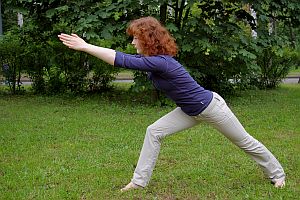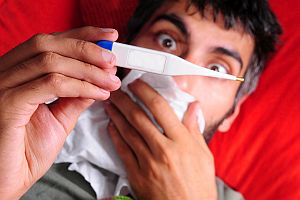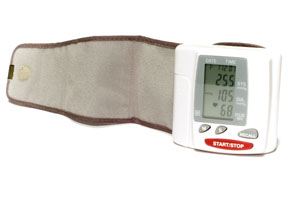What Causes Muscle Tension?

Muscle tension occurs when a muscle (or group of muscles) remains contracted for an extended period of time. This might be characterized as a low-energy or low-intensity muscle cramp. Such tension in the muscles constricts blood flow, which in turn keeps oxygen and nutrients from reaching the muscle tissues and tendons. Muscle tension also keeps cellular waste from being carried away. The result is more muscle tension, spasms and damage. Why does this happen? There are actually several possible causes.
One key source of muscle tension is stress or anxiety. For our ancient ancestors, stress was a simple fact of everyday life, and their ability to response effectively to imminent threats (predators, hostile neighbors, natural disasters, etc.) was an integral part of their survival. As a result, their bodies evolved a set of short-term physiological changes that helped them to meet sudden life-and-death challenges by increasing their alertness, strength, speed and stamina. Today, we refer to these changes collectively as the “fight-or-flight” response, and they’re part of our evolutionary inheritance.
Unfortunately, there is now a kind of mismatch between the kinds of modern threats (real or perceived) that most of us encounter in our day-to-day lives and our bodies’ primitive fight-or-flight response. Instead of short-term physical dangers, modern stress is much more likely to come from social or financial pressures that are (usually) lower-intensity but more prolonged. Mounting bills, insane work deadlines and relationship problems are all great examples. This is a problem because our fight-or-flight response was really designed to be “switched on” only for very short periods of time—essentially, just as long as it took us to either defend ourselves or escape from a physical attack. It turns out that the human body pays a high price for the fight-or-flight response, and this price is especially high when the response is activated continuously over long periods of time, even at relatively low levels. Chronic muscle tension is just one potential result.
Muscle tension can also be the result of underlying structural problems or injuries affecting the musculoskeletal system, especially in the back or neck. When the spine is misaligned or there is an injury, the body may compensate by activating other muscles or muscle groups to stabilize the area and prevent pain. These muscles are put under additional strain for which they were not designed, leading to chronic muscle tension.
Chronic muscle tension itself can lead to new kinds of discomfort and pain. The pain can lead to an increase in anxiety and more muscle tension. This becomes a vicious cycle—an unhealthy, downward spiral. Luckily, there are a number of different ways to relieve muscle tension.
One of the best ways to relax your muscles is to exercise. This may seem counterintuitive at first, but muscle use increases blood flow and, accordingly, reduces the tension caused directly from lack of such blood flow. Exercise also produces endorphins which help to relieve stress and anxiety.
Heat is another method of relief. It can help by opening up blood vessels and relaxing the tense muscles. Use care when applying a hot pack. With heat, you can do too much of a good thing. Use a cloth between the pack and the skin so the heat remains measured and soothing. If you use an electrical heating pad, do not lie on the pad, but lay the pad on the tense muscles.
Water therapy can also help reduce muscle tension. Floating in a swimming pool or on a waterbed can prove to be extremely therapeutic because of the relaxing nature of wave action on the body.
Of course, a massage therapist is an expert at helping muscles relax. A truly good therapist can adapt his or her technique to your specific situation and will be skilled at gradually building up the intensity of the massage so that you’ll receive all the therapeutic benefit without losing the relaxation benefit.
Remember—it’s important to understand the underlying cause of chronic muscle tension so that it can be addressed in an effective way. Your chiropractor is specially trained to determine if the underlying cause is structural. If it is, he or she may be able to perform adjustments to correct the problem. Depending on your specific situation, your chiropractor may also recommend a treatment plan that includes several of the therapies mentioned above in order to relieve your pain and restore your mobility as quickly as possible.
How to Know if Stress is Affecting Your Health and Well-Being
 Everyone deals with stress in their lives. And—in small doses—this can be a very good thing. Manageable amounts of stress can actually help you perform at your best and may even help you develop your abilities. However, far too many of us are stressed to the point that our health and well-being could be compromised.
Everyone deals with stress in their lives. And—in small doses—this can be a very good thing. Manageable amounts of stress can actually help you perform at your best and may even help you develop your abilities. However, far too many of us are stressed to the point that our health and well-being could be compromised.
Stress: Helpful or Harmful?
When you are in a dangerous situation, your body responds with a rush of chemicals. This “flight-or-fight” response leads to an increased heart rate, quicker breathing, and higher blood pressure. In a truly dangerous situation, this response helps you make fast decisions and prepares your body for quick action that could save your life. Your body is able to handle this response in small doses over short periods of time, but when your body is constantly on “high alert,” your health pays the price.
Unfortunately, your body doesn’t differentiate between a physical threat (such as being attacked by a bear) and a psychological one (such as being three months behind on your electric bill). Therefore, everyday life is filled with interactions that could trigger a stress response in certain circumstances. A car honking at you on the highway, your boss reprimanding you in front of your peers, a call from your child’s teacher, and hundreds of other common occurrences can have a very real impact on your physical, cognitive, and emotional well-being. And their effects can and do add up.
The Symptoms of Stress
Constant or repeated stressful incidents can take a heavy toll. The most insidious part of ongoing stress is that this toll is not always easy to spot. Stress levels can build up slowly, and many people become acclimated to a “new normal” without realizing that it’s happening. Knowing how to spot the symptoms of stress can help you break the cycle by either addressing the underlying causes or by finding more effective ways to deal with the stress itself.
Have you noticed any of the following symptoms?
- Constant worrying or anxiety
- Inability to concentrate
- Agitation or irritability
- Feelings of loneliness, isolation, or depression
- Digestive issues, such as upset stomach, diarrhea, or constipation
- Insomnia or low energy levels
- Chest pain or rapid heartbeat
- Appetite changes
- Substance abuse
- Nervous behaviors, such as fidgeting or nail biting
These are just a few of the signs of stress overload. Consistently feeling stressed can also exacerbate other health problems, including infertility, depression, skin conditions, autoimmune disease, and heart disease. Stress may also encourage people to turn to unhealthy coping mechanisms, such as overindulging in comfort food, drinking or smoking too much, or lashing out at friends and family, which can further impact their physical and emotional well-being.
Healthy Ways to Cope With Stress
Coping with stress in a healthy and productive way can help you to manage its physical, psychological and emotional impacts. While you can’t always control the stressors in your life, you can control how you respond. By avoiding unnecessary stress, adapting to new situations, and accepting the things you can’t change, you can reduce the physical toll stress takes on your body.
Improving your overall physical health can also improve your body’s response to stress. It might be difficult to know where to start, so consider meeting with your chiropractor to learn more. Your chiropractor can help you create lifestyle strategies to leave you feeling healthier, happier, and better able to deal with life’s many stressors.
Thinking About Food Labels: What the Future Might Bring

In a move applauded by nutritionists and health experts (but criticized at the same time for not going far enough), the Obama administration has proposed sweeping changes to the regulations surrounding the labeling of packaged foods. The new proposal, announced and championed by first lady Michelle Obama, aims to make it easier for consumers to figure out whether a packaged food product is healthy or unhealthy, and whether it contains large amounts of ingredients that are potentially harmful to their health.
These proposed changes have been long in coming—the current standards were first introduced over 20 years ago, in 1993. Much has changed since then and Americans have become “supersized” in more ways than one. They are eating larger portions of foods than they did in 1993, and more is known now about the effects of harmful ingredients like hydrogenated oils, trans fats, and sugar than was known then. But today’s labels still hold to the old standards, which allow manufacturers to create “serving sizes” that are completely unrealistic, and to bury useful information like the actual amount of calories, fats, and sugars you’re likely to consume in the “fine print” of the label.
As an example, the current labeling standards allow manufacturers of soda to list its calories and sugar content based on a “serving size” of eight ounces, whereas the actual bottles of soda (which are almost always consumed in one sitting) contain 20 ounces, or 2-1/2 times more. Ice cream manufacturers currently use half a cup as the “serving size” used to calculate their products’ calorie and sugar counts, whereas most Americans consume an average of two cups when they eat ice cream.
The proposed standards would change this, and instead of listing calories “per serving size,” they would list them as “amount per 2/3 cup,” or using a similar easily recognized measure. Because of national and global concerns about obesity, calorie counts would no longer appear in small print, but be highlighted in a large font. Each packaged product would list the “number of servings per package” in a more prominent location and font. Also, for the first time, a new indicator called “Added Sugars” would be included on every label, which again relates to calories, because Americans consume over 16% of their total calories from sugar.
“Calories From Fat” would no longer be listed, because more recent science tells us that it’s the type of fat that is more important for consumers to know about. Therefore, labels will list amounts of “Total Fat,” “Saturated Fat,” and “Trans Fat.” The US Food and Drug Administration (FDA) would also update their recommended “Percent Daily Values” (%DV) ratings for common nutrients to bring them into line with current science, and would finally add Vitamin D and potassium.
While all of these proposed changes are legitimate improvements, it’s (of course) impossible to please every special interest group that will be affected by new labeling regulations. Although consumers themselves will doubtlessly benefit, consumer advocates are disappointed because they were lobbying for changes like indicating added sugars, saturated fats, and trans fats in a bold, colored font to indicate that they are present in high amounts. On the other side of the argument are food manufacturers and retailers who worry about the cost of new labeling requirements and what the new information might mean for buying behavior.
The bad news is that these proposed food labeling requirements are not slated to take effect for at least two years. The good news is that the FDA has put in place a very robust process designed to allow stakeholders to “weigh in” and contribute their suggestions. You can learn more about that process at www.regulations.gov and searching for the term “food labeling”.
Use it or Lose it: Five Tips for Maintaining Your Sense of Balance Beyond Middle Age
 If you are middle-aged (40-60, by some definitions) or older, here’s 15-second self-test for you. Do you often find yourself needing to sit down or steady yourself against a table when putting on your shoes or stepping into pants? Do you increasingly need to use the armrests of your chair to “push off” when getting up? Do you generally hold on to handrails whenever you go up and down stairs? If you stand with your feet close together, do you feel unsteady and unable to balance yourself properly?
If you are middle-aged (40-60, by some definitions) or older, here’s 15-second self-test for you. Do you often find yourself needing to sit down or steady yourself against a table when putting on your shoes or stepping into pants? Do you increasingly need to use the armrests of your chair to “push off” when getting up? Do you generally hold on to handrails whenever you go up and down stairs? If you stand with your feet close together, do you feel unsteady and unable to balance yourself properly?
If you’ve answered “Yes” to any of these questions, you might want to start giving a little bit of thought to your sense of balance, and how important it is to you. It’s easy to take good balance for granted—most people don’t give it a first or second thought until after they’ve experienced a fall. However, the behaviors we asked about in our self-test are actually “early warning signs” that your sense of balance may be starting to deteriorate. Your balance is controlled by an area of the brain called the cerebellum, which works in coordination with your vestibular (inner ear) system, your visual system (your eyes, and their ability to perceive whether you are standing upright), and your proprioceptive system (your body’s sense of position in space).
All of these systems begin to deteriorate once you pass the age of 40, as do the muscles they control. Worse still, this process of deterioration can become accelerated if you lead a sedentary lifestyle (which growing numbers of Americans do). And although you might not think of balance as a health issue, falling is the leading cause of injury for people over the age of 65. In the U.S., someone from this age group is treated in an emergency room for injuries resulting from a fall every 17 seconds.
So how do you improve your sense of balance, and protect yourself from dangerous falls? Simple—use it! Balance is to some extent a learned skill, so if you practice a few simple exercises that isolate these components of balance, you can actually make your sense of balance better. Experts on aging suggest performing a few exercises to improve your balance each day, starting in middle age, before the systems that control your balance have begun to deteriorate.
For example, just avoiding the use of handrails on stairs or the poles in buses and subway cars forces your body to work harder to maintain its balance, improving reflexes, increasing coordination and strengthening your muscles. Other exercises you can perform include creating an unstable surface at home (such as a board placed on wobbly pillows) and then practicing standing on it with one foot, or improving your coordination by standing on one leg with the opposite arm extended and then swinging the other leg back and forth. Office workers can improve their balance—and get a refreshing break at the same time—by practicing getting up from their chairs ten times in a row without using their hands. Each of these simple movements shifts your center of gravity, causes your muscles to react to changing positions, and improves your balance.
Just walking in a small circle around your living room or your backyard can be good for your balance, because walking along a curve is more difficult than walking in a straight line. When you’re out for a walk, try to choose uneven surfaces rather than smooth pavement because this also exercises the muscles in your back and legs that are essential for good balance. Or place cones or other objects in a line on the floor in front of you and then weave between them while walking. You can strengthen your hips, which are very important for balance, by holding on to a table or a kitchen counter and then swinging one leg forward, to the side, to the back, and then up to your chest with your knee bent. Do this ten times, and then switch to the other leg and repeat. Yoga, Tai Chi, martial arts, and other forms of exercise that emphasize flexibility can also improve your balance.
So if you are concerned about protecting yourself against falls as you age, the important thing to bear in mind is the phrase “use it while you’re young, or you’ll lose it as you age.” The more healthy exercise you get in your 30s and 40s, the more healthy – and safe – you’ll be in your 60s and beyond.
Standing More Often: A Prescription for Better Health?

It seems that almost every day we see new research coming out about the perils of inactivity and sitting too much. We’re becoming a sedentary nation, and it’s taking its toll on us, causing or contributing to epidemic levels of Type 2 diabetes, heart disease, and cardiovascular problems. So it’s interesting to look at some of the research that’s being done on the “opposite of sitting”. And no, that’s not necessarily exercising—it’s standing. Some studies are indicating that simply standing for a few more hours per day may be even better for your health than joining a gym.
While this type of conclusion may be startling at first, it’s much less shocking when you stop to consider the number of hours that we actually spend sitting each day. One recent study found that most Americans spend up to 12 hours a day sitting. If you add in the hours we spend sleeping, that means that most of us spend up to 20 hours a day being sedentary. One sad result of all this physical inactivity: Those who sit all day long live an average of two years less than those who are more active. Even regular exercise doesn’t seem to completely offset the effects of sitting all day.
So how could standing more help? Well, for one thing you burn about twice as many calories while standing as you do while sitting. For another, standing improves your circulation and tends to prevent the numerous vascular disorders linked to sitting for prolonged periods of time.
The first scientific studies linking standing more often to improved health were done in the 1950s in Britain, comparing bus drivers (who sit) with bus conductors (who stand). The resulting study, published in The Lancet, indicated that the conductors had about half the risk of developing heart disease as the drivers.
More recently, a large research project conducted in Australia as part of The 45 and Up Study examined 194,545 participants and asked them to self-evaluate their overall health and quality of life using a 5-point scale. The amount of exercise the participants got was rated using a standard scale, while the number of hours spent sitting were self-assessed. The results, published in the American Journal of Preventive Medicine, found that prolonged sitting reduced muscle contractions and shut off the activity of lipoprotein lipase, which helps to turn fat into energy. As a result, there was more obesity in the inactive group, and they died earlier than their counterparts who sat fewer hours per day. Women in the study who spent more than 11 hours per day sitting had a 12% increase in all-cause premature mortality, and the sedentary group also had increased risk of death from cardiovascular disease, coronary heart disease, and cancer. Men in the study who spent more than five hours a day outside of work sitting were 34% more likely to develop heart failure than those who spent no more than two hours a day sitting, regardless of how much they exercised.
So the facts seem to be in. Standing more often seems to be good for you. How to achieve this is a more difficult question, because so many offices are designed around the idea of sitting at a desk most of the day. But many forward-thinking companies are either installing “standing desks” for those who ask for them or, like Google, instituting required “stand up and walk around” breaks every hour. No matter how you choose to do it (even if it’s resting your laptop on an ironing board so you can stand while you work), try to avoid sitting as much as possible for greater health and longevity.
Exercise as Medicine: Spotlight on Walking
 Do you want to become healthier and stay healthy longer? Take a walk. That is the message of two important new studies.
Do you want to become healthier and stay healthy longer? Take a walk. That is the message of two important new studies.
In the first, from Tel Aviv University in Israel, researchers found that a simple aerobic program based on walking was as effective in alleviating lower back pain as muscle-strengthening programs that required specialized rehabilitation equipment. The researchers recruited 52 patients with chronic lower back pain, and assigned half of them to complete a six-week, clinic-based muscle-strengthening program, exercising under supervision two to three times a week. The other half of the patients spent the six weeks of the study walking for 20-40 minutes two to three times a week.
According to study leader Dr. Michal Katz-Leurer, in research published in the journal Circulation, the walking program was “as effective as treatment that could have been received in the clinic.” He explained that when people walk, their abdominal and back muscles are forced to work in a similar way as when they complete rehabilitation exercises targeting those areas. And unlike rehabilitation, which requires specialized equipment and expert supervision, walking is an activity that can be performed alone, and easily fit into a person’s schedule.
In the second study, researchers from Brigham and Women’s Hospital in Boston analyzed data collected on the activity and sitting habits of 36,000 older men, over a period of 24 years. The researchers determined how much time the men spent sitting, performing other activities, and walking, and whether they walked at an easy, average, or brisk pace. What they found was that even a little walking each week significantly lowered the risk of hip fractures in men over 50.
Over the period of the study, which was published in in the American Journal of Public Health, 546 hip fractures occurred, 85% of which were from “low trauma” events such as slipping, tripping, or falling from a chair. The study data indicates that the more the men walked, and the more vigorously they walked, the lower their risk of hip fracture was as they aged. Walking over four hours per week was identified as the point at which the most significant benefits occurred, providing a 43% lower hip fracture risk than in men who walked only one hour a week.
Study author Diane Feskanich says about her findings, “It’s well known that physical activity helps to prevent hip fractures, that it helps to build bone and muscle tone. It can help with balance, too. One thing we’re pointing out here is that it doesn’t necessarily have to be strenuous activity. A lot of studies have focused on the benefits of strenuous activity, but we found walking alone helped to prevent hip fractures, and when you come down to it, older people are often more comfortable with walking.”
For Many Kids, Back to School Means Back to the Doctor. Here’s How Parents Can Help
 With Halloween two weeks behind us and Thanksgiving less than two weeks away, most school-age children are back in the classroom and (hopefully) have adapted to the fall routine. For some kids, though, the fall routine includes lots of sick days and doctor visits.
With Halloween two weeks behind us and Thanksgiving less than two weeks away, most school-age children are back in the classroom and (hopefully) have adapted to the fall routine. For some kids, though, the fall routine includes lots of sick days and doctor visits.
According to the U.S. Centers for Disease Control and Prevention (CDC), there’s a good reason for this. “Schools inherently foster the transmission of infections from person to person because they are a group setting in which people are in close contact and share supplies and equipment.”
The CDC also provides some statistics that puts this issue in perspective: “Infectious diseases account for millions of school days lost each year for kindergarten through 12th-grade public school students in the United States:
- 40% of children aged 5–17 years missed 3 or more school days in the past year because of illness or injury.
- Nearly 22 million school days are lost each year due to colds alone.
- 38 million school days are lost each year due to the influenza virus.”
Naturally, schoolchildren aren’t the only ones who are affected when even common illnesses are passed from child-to-child in the classroom environment. Those same illnesses (or the microorganisms that cause them) ride home with kids on the bus or in the neighborhood carpool. And when they do, the whole family is at risk. Plus, parents are left to cope with the inconveniences and costs that come with sick days and doctor visits.
Communicable diseases that spike at the beginning of the school year are numerous and include the common cold (aka rhinovirus), the flu, strep throat, Fifth disease (a viral infection caused by the parvovirus), pinkeye, whooping cough (aka pertussis), mono, chicken pox, meningitis, lice, scabies, pinworm, ringworm, jock itch, and athlete’s foot.
Some areas of the country are also concerned with two other viral infections that thrive in crowded areas such as schools. According to Indiana news station WTHR.com, “The first is a viral infection called ‘hand, foot and mouth disease.’ ”
Noted pediatrician Dr. Michael McKenna from the Riley Hospital for Children at IU Health says in regard to hand, foot, and mouth disease, “The rash looks ugly, kids feel uncomfortable, and they can have fevers. The one concern is if they have so many ulcers in their mouth that they refuse to eat or drink, that they can become dehydrated. This year, it’s much more prominent and the rash is much more severe.”
The article continues: “Doctors are also seeing many more cases of shigellosis, a bacterial infection spread when people do not wash their hands after using the bathroom. It can cause diarrhea, nausea and vomiting.”
Children aren’t the only ones at risk for transmittable infections and diseases in and around the classroom—teachers and administrators are also susceptible to many viruses and bacterial infections, which range from simply annoying to very serious. In fact, many teachers quickly get sick upon the arrival of a new school year. For these people, it is important to practice prevention. Minimize contact with students, urge them to cough and sneeze into their elbow, and send them to the nurse if they look as if they may be coming down with something.
So else can parents do to try to keep their kids healthy and at school during the fall and winter months? Here are a few thoughts we’d like to share:
- Teach your children good hand-washing habits that follow them from home to school and be sure that they wash their hands when they return from school in the afternoon.
- Explain to your children the importance of keeping their hands away from their eyes, nose and mouth throughout the school day and discourage them from sharing cups, utensils, etc.
- Encourage your children to eat a healthy, balanced diet that will support their immune system.
- Make sure your children get plenty of fresh air and exercise. Spending time outside and away from crowded, enclosed areas can help reduce the likelihood of sickness.
- Set a reasonable bedtime for your children and stick to it. Not only are well-rested kids likely to perform better at school, they’re also more likely to stay healthy.
- If your children are sick, please keep them home until they are well. This is for the benefit of classmates and teachers, but it’s also for the benefit of your own kids. Children who have not yet completely recovered and return to school to early may be more likely to pick up additional illnesses in the classroom.
Have a Cold? Top Ten Tips for Getting Better Faster

The common cold: Even though Americans have over a billion colds per year, there’s nothing “common” about it when you’ve got one. The sneezing, the scratchy throat, the runny nose, the nasal congestion, and the watery eyes can make your life miserable. Even though most colds go away within three to seven days, there are steps you can take to boost your body’s immune system and help get rid of your cold sooner than that. Read on for our “Top 10 Tips” on getting over your cold quickly, consolidated from healthcare experts all over the world.
- First, make sure you’ve really got a cold. The symptoms listed above are those of the common cold, which is a disease of the upper respiratory tract caused by a number of different viruses. But if these symptoms are accompanied by more severe ones such as muscle aches, high fever, chills, headache, and fatigue, chances may be that it’s not a cold at all, but the flu instead. This is important to find out, because if you have a serious case of the flu, you may need to see a doctor and take an antiviral medication like Tamiflu, which can shorten the length of the outbreak. However, if you’ve got a cold, not only will the antiviral medication be ineffective, it can even weaken your immune system in the long run.
- Don’t “tough it out”—stay at home and get some rest. Going to work will only make your cold last longer, and you can expose all your coworkers to the virus as well. So take a few days off and give your body the rest it needs to recover and heal faster.
- Drink lots and lots of liquids, including—yes, really—chicken soup. Your mother’s advice to drink lots of fluids was correct, as it turns out. Research has shown that drinking warm fluids helps to relieve the most common cold symptoms and also loosens sinus secretions that cause a buildup of mucus. Hot tea or broth is a good choice, as is coffee, which has been shown to increase alertness in people with colds. And interestingly enough, the centuries-old prescription to “Have a nice bowl of chicken soup.” is also correct—it has been shown to be more hydrating and thus more beneficial than other liquids.
- Gargle with salt water. Gargling with 1/2 teaspoon of salt dissolved in 8 ounces of water can help to relieve your sore or scratchy throat.
- Use over-the-counter medications (very selectively) to deal with runny nose and coughs. A pharmacy has reliable saline nose drops or sprays and cough syrups that can help to make these cold symptoms more bearable, although they won’t make the cold go away any faster.
- Steam the cold away. If you have access to a steam bath, take one—or many. If you don’t, you can improvise by leaning your head over a bowl of hot water or by taking a long, steamy shower. Inhaling warm, moist air helps to loosen and thin out mucus.
- Boost your immune system with supplements. Research has shown that taking zinc supplements during the first couple of days may help shorten the duration of your cold and perhaps reduce its severity. But don’t take zinc on an empty stomach, and don’t use intranasal zinc nose drops or sprays; the FDA has warned that they can permanently impair your sense of smell. Vitamin C can also help to shorten colds, whether in supplement form or in fruits and vegetables. Echinacea, elderberry syrup, and raw honey have also been shown to shorten colds.
- Avoid smoke and polluted air. Anything that affects your ability to breathe properly is going to extend your cold.
- Don’t reinfect yourself or others. Practice “safe sneezing and coughing” by covering your nose and mouth and carefully discarding any tissues you use. Wash your hands often and consider using hand sanitizers to keep from infecting family, friends, coworkers, and yes, even yourself. If you contracted the cold at work and others there still have their colds, avoid the place for a few days if you can until people get better.
- Use over-the-counter pain relievers to reduce inflammation. Used in moderation, aspirin, acetaminophen, ibuprofen, and naproxen can all help relieve minor bodily aches that may accompany your cold, but they also act as anti-inflammatories and can reduce a fever and speed up the healing process.
Natural Approaches to Lowering Blood Pressure

High blood pressure (hypertension) often has no visible symptoms, especially early on. The only way to determine your blood pressure is to have it measured. If you have high blood pressure, lowering it is vitally important to your long-term health and to reducing your risk of cardiovascular disease.
Risk factors for high blood pressure include the following:
- Being Overweight—If you are overweight, this will put extra pressure on your artery walls
- Inactivity—If you don’t exercise, you increase your risk of high blood pressure
- Stress—Increased and prolonged stress can raise blood pressure
- Alcohol consumption—Overdoing the drinking of alcoholic beverages can increase the risk
- Potassium—If your potassium level is too low, cells tend to compensate with more sodium, which places you at greater risk
- Sodium—Too much sodium in your diet leads to fluid retention and higher blood pressure
- Age—As you get older, your risk increases
- Genetics—Some families have greater risk of high blood pressure than others
- Sugar—Excessive sugar intake, especially refined sugar, can lead to diabetes, which is frequently associated with high blood pressure
- Inflammation – inflammation can be blamed for a whole host of health complaints and should probably be the first issue addressed. All of the risk factors listed above can be related to or be affected by inflammation. Eating a diet which contains REAL foods and that includes lots of fruits and vegetables is key in helping to reduce inflammation in the body!
While you cannot influence some of these factors (such as genetic disposition and aging), it is possible to manage most of the items on this list.
Exercise is one very effective way to reduce high blood pressure. First of all, it increases your general level of activity. Second, it tends to lower your weight. And third, it helps to reduce stress because of the release of endorphins. Yoga and biofeedback have also been found to be beneficial in reducing stress.
When it comes to diet and blood pressure, bananas can be a useful addition. Bananas are a rich source of potassium and can help normalize the potassium-sodium balance in your cells. Limiting the sodium content of your food is also important. Eliminate refined sugar from your diet. Relying on fruit and natural 100% fruit juices to sweeten your diet can be one of the best things you can do.
Alcohol, like most everything else, should be taken in moderation. If you have too much stress in your life, realize that alcohol is a depressant and cannot help in the long run. Exercise is a much better stress reliever.
A few herbs are believed to contribute to high blood pressure risk:
- Asian Ginseng
- Licorice
- Rosemary essential oil
- Ephedra
Calcium and magnesium have been found to improve blood pressure. In particular, they’re associated with improving nerve action, calming nervous tension and reducing jitters.
These substances also help reducing high blood pressure or its risk:
- Coenzyme Q10 (CoQ10)
- Garlic (may interfere with other medications, so check with your doctor)
- Hawthorn (a natural herb with no known interactions with medications)
- Fish oil
- Folic acid
- Cayenne pepper
If you have high blood pressure, be sure to consult with your doctor before following any of the above suggestions. But rest assured that there are natural ways for you to manage your blood pressure without resorting to drugs.
